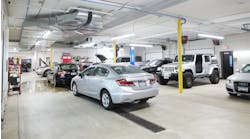Most shop owners learned the business in the bays, not in an accounting class.
Like this article? Sign up for our enews blasts here.
That’s just fine, and where Bob Greenwood with the Automotive Aftermarket E-Learning Centre Ltd. comes in.
Greenwood understands the numbers shops need to hit to be profitable, and on Thursday afternoon helped owners understand what their banks look for in his presentation, “Reviewing the Formal Financial Statement as the Bank Does.”
Using simple balance sheets as examples, Greenwood walked attendees through six items banks look for on a shop’s account statement (i.e. the forms owners submit with tax returns).
The current ratio was one item Greenwood covered. Sometimes called the working capital ratio, this tells the banker how easily the shop can meet its current debts. The bank looks at the current asset, inventory, cash in the bank, receivables if there are any, and divides that by the shop’s current liabilities.
“What the bank’s looking for, is a current ratio above the generally accepted 2 to 1, which means current assets twice as much as current liabilities,” Greenwood says. “The stronger that number is, the higher that number is (3 to 1, 4 to 1, for example), the bigger the smile the bank has on its face.”
Attendees received handouts to help them in their shops address the six items Greenwood covered in the session. Between the sheets and examples in the presentation, he says he can help the owners recognize what the bank is looking at and why it is important.
“I think most, going back to simple shop owners that are running a business that are technicians that have really not had any formal business training, and they don’t really understand the banking business, banks are not in the risk lending business, they’re in the equity lending business,” Greenwood explains. “If a business doesn’t have good equity, next thing you know, banks are going to over-secure a business loan buy taking on a lot of personal collateral, because the business is not strong enough to stand on its own.”
He also tied the importance of these six areas and understanding these statements to what older shop owners need to know as they create their succession plans.
Have articles like this sent to you weekly by signing up for our enews blasts here.


